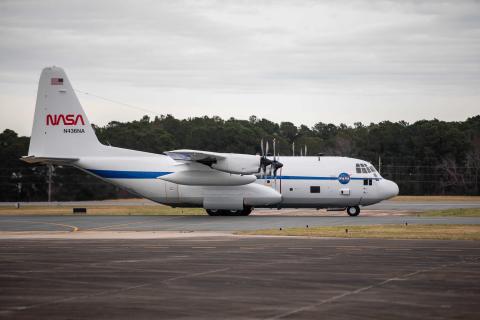
The NASA Goddard Space Flight Center’s (GSFC) Wallops Flight Facility (WFF) Aircraft Office operates a NASA C-130H Hercules (N436NA) research/cargo aircraft to support airborne scientific research activities and movement of NASA cargo. The C-130H is used to perform scientific research, provide logistics support on an as-needed basis to other NASA missions, and can be used as a technology test bed for new airborne and satellite instrumentation. The aircraft is also available to support NASA range surveillance and recovery operations as needed. The C-130H is a self-sufficient aircraft that can operate from short field civilian and military airports to remote areas of the world in support of scientific studies and other operations.
The C-130H is a four-engine turboprop aircraft designed for maximum payload capacity. The C-130H, NASA 436, has been modified to support airborne science related activities as well. The aircraft has three 16 inch diameter nadir ports. Two 20x30 inch rectangular and four 10 inch diameter fuselage windows. A zenith port exist in the flight station for small instruments as well as sonobuoy/dropsonde tubes on the cargo ramp. An experimental power system is installed in the aircraft capable of producing 115VAC 60Hz, 400Hz and 28VDC. The aircraft contains a state of the art avionics and communications suite to support a variety of world wide missions. The aircraft also is capable of carrying 6 cargo pallets that can be utilized to carry cargo or modified to support instrument racks and seats. The large rear cargo door/ramp allows for easy installation of large instruments, payloads and cargo. The aircraft is equipment with external fuel tanks to increase range and duration. A cargo airdrop system is also installed in the aircraft to perform cargo drops from a variety of altitudes which has been demonstrated numerous time supporting the Commercial Crew Program parachute airdrop testing.
The GSFC/WFF Aircraft Office is committed to providing safe, reliable, and cost effective platforms for airborne research and other flight activities.
* The performance numbers presented below are based on a 25,000lb payload. Heavier payloads may reduce aircraft range and duration. Maximum Take Off Weight is 175,000lbs however, 155,000lbs is the Maximum Normal Take Off Weight.
** Airspeed indicated below is Knots True Airspeed (KTAS).

